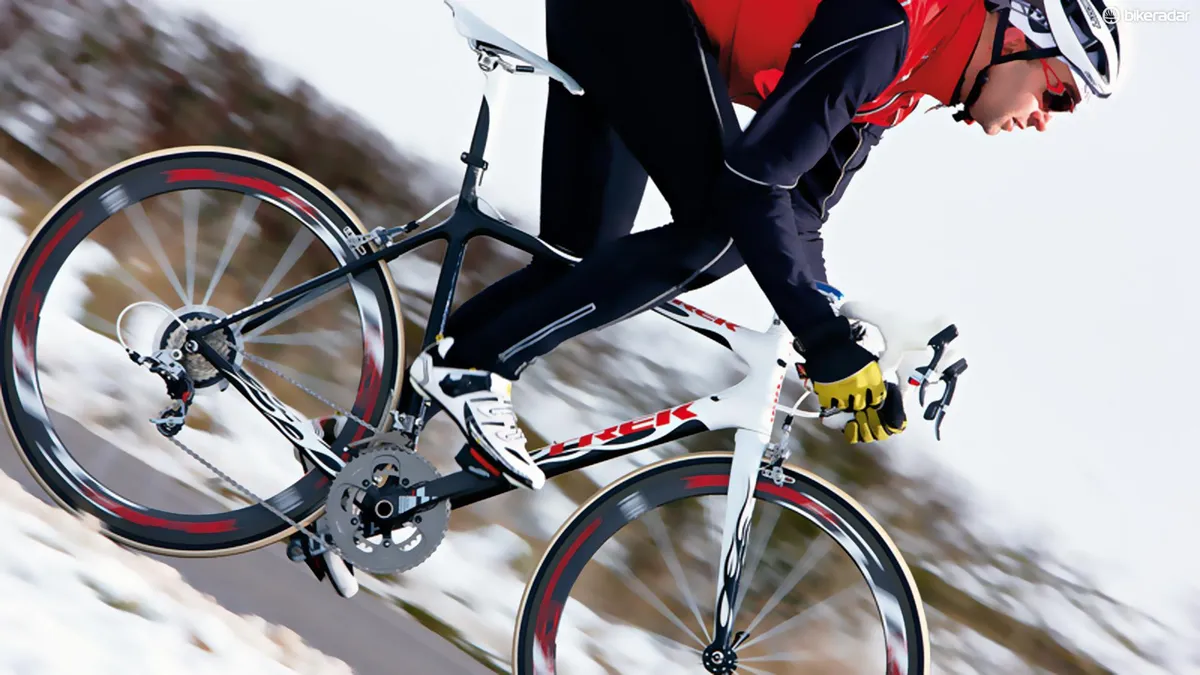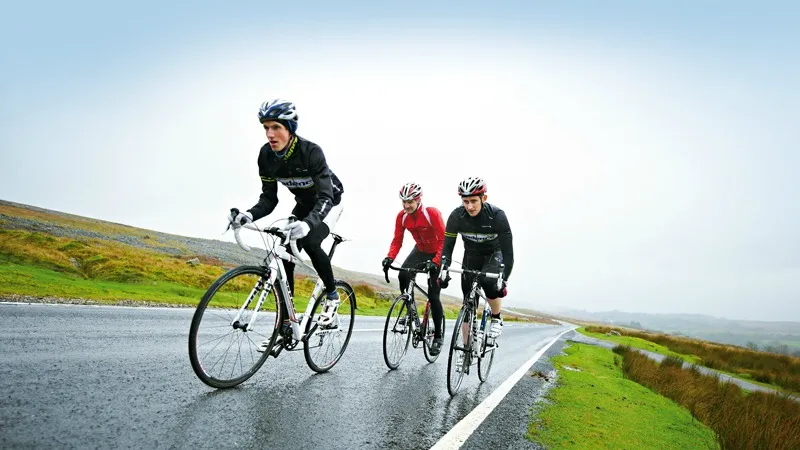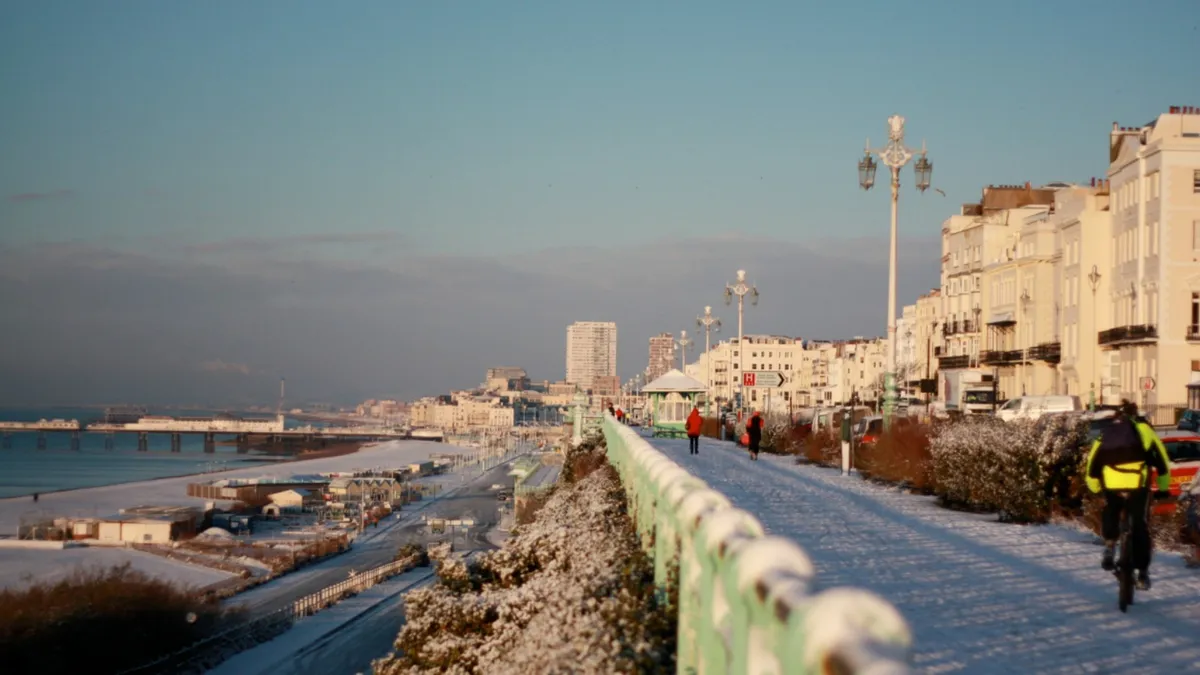The thought of winter cycling is often enough to put off even hardened road riders — surely it's dangerous, how do you even ride on icy roads? A turbo trainer or lie-in can seem like a preferable alternative to battling through ice, sleet, rain or a freezing wind trying to stay warm and upright on your bike.
- Complete guide to winter road cycling
- Best winter cycling clothing
- Prepare a road bike for winter riding
But with the right winter cycling kit and these essential safety tips you should still be able to get out there and enjoy the same health and fitness benefits you did in the summer. Many coaches and veteran year-round riders even say that braving the elements can give your mental toughness a boost, a benefit you’ll really notice when you’re in need of some determination during a sportive, race or demanding summer ride.

How to ride on icy roads
- Pick your road carefully – stick to those that have been treated
- Be wary of exposed sections of road – the wind chill can create extra ice
- Go around icy patches if you have time and it's safe to do so
- if you can't avoid the ice, don't make any sudden moves – try to ride it out
Lingering frost or black ice can catch anyone unawares, especially given that crisp winter days and blue skies are so inviting for a bracing ride. Stunning cloudless days go hand in hand with sub-zero nights. And when the sun does come up it stays low in the sky and relatively weak, with long shadows.
Add to that the time-poor training cyclist’s preference for early morning rides and there’s a high chance some of those shadows will be icy and make your wheels lose grip.
One of the biggest causes of black ice is when a big freeze follows a partial thaw, so that rain water or meltwater is frozen before it can drain off the road completely, leaving a thin layer of transparent ice.
If you’re riding in these conditions, pick your road carefully and stick to those that have been treated. Of course, the downside to this is that many councils put a water dispersal agent down with the salt, and after a few days this too can be slippy.

Be particularly wary of the more exposed sections of road, such as where there are no hedges — the wind chill will have further cooled the tarmac there — and always keep your eyes on the road ahead so you’re prepared for icy hazards, going round them if you have time and it’s safe to do so.
If you’re about to hit ice then don’t do anything sudden — don’t turn the bar too fast or far or lean the bike, and don’t brake hard or suddenly. Of course, if you hit black ice on a downhill corner, all you can do is hope for a soft landing…
How to ride in the wet
- Take into account the longer stopping distances required
- Be careful riding on road markings, drain and manhole covers, especially when turning
- Apply your brakes in equal measure when it's raining – 50 percent on the front, 50 percent on the back
Riding a bike in the wet can be great fun, but make sure you do it safely. Cycling coach Andy Cook points out that it will take you longer to stop when braking in the wet because of a build-up of water on the rims between the brake blocks and the braking surface. Make sure you take this into account.
Also, road markings tend to be slippery when wet, as do drain and manhole covers, so remember to take extra care when riding across them, especially when turning. Avoiding them is the best idea, but if there’s no alternative, anticipate your line and speed — a sharp turn over a wet piece of ironwork or painted line at speed could easily result in a fall.
British Cycling club coach Dan Bennett, who runs Progressive Cycle Coaching, recommends applying your brakes in equal amounts when it's raining: “50 percent on the front, 50 percent on the back — and ride a little further towards the middle of the road — you’ll be less likely to pick up flints and other stones washed off the verges that may cause punctures."
How to ride in windy conditions

- By far the best way to beat the wind is to ride in a group (but don't shirk your turn at the front)
- If you're on your own, avoid the wind by seeking out natural windbreaks such as hedged lanes
- Reduce your frontal area by rounding your shoulders and bending closer to the handlebars
- If it's a blustery wind, grip on a little tighter so you don't lose control
Sometimes called ‘the invisible hill’, a stiff wind can turn a pan-flat road into a relentless climb, and make even a modest ascent feel like Alpe d’Huez. All the more reason to get out in it, says Bennett.
Reduce your frontal area by rounding your shoulders and bending down closer to the bar, as this will help reduce wind resistance
“The increased wind resistance makes it harder to pedal, which will increase your heart rate, power output and leg strength, and help you to mimic riding uphill if you live in a flat area. Like riding in the rain, it will increase your resilience to tough conditions, and get you ready for riding windy sportives such as Paris-Roubaix.”
As anyone who’s tried it – or just watched the pros – will attest, the best way to beat the wind is to ride in a group. “Riding behind one rider at 30kph, you’ll use 18 percent less energy. That rises to 27 percent at 40kph and 39 percent if you’re in a bunch,” he explains.
What if you’re riding on your own? “Try to avoid the wind by heading into hedged lanes, and if you head into the wind on the first half of the ride, you can then turn around and get blown back home. Riding with the wind behind you allows you to mimic the greater speeds associated with bunch riding.”
And when there’s really no escape, he offers some tips for making windy rides a bit less painful: “Reduce your frontal area by rounding your shoulders and bending down closer to the bar, as this will help reduce wind resistance. If it’s a blustery, gusting wind, choose an easier gear, move slightly further into the middle of the road and hold onto the bar a little more tightly, so you’re ready to control the bike more at short notice.
“If you’re trying to stick to a set wattage or heart rate zone, you’ll need to increase or decrease your efforts depending on wind strength. If it’s reaching gale force, probably best not to head out but spend the time on the turbo.”
